Explore topic-wise InterviewSolutions in .
This section includes InterviewSolutions, each offering curated multiple-choice questions to sharpen your knowledge and support exam preparation. Choose a topic below to get started.
| 4801. |
Question : A group of college students shared their phone number on social media. They insist the people to donate their used clothes, books, toys, utensils, etc. They collect such used items and distribute to the needy. 'Robinhood' is a well-known name at national level. Members of this group collect the food that is left in restaurants and at the occasion of marriage and distribute to needy. Is this environment-friendly practice ? |
| Answer» SOLUTION :YES, this is an environment-friendly PRACTICE. | |
| 4802. |
Question : A group of college students shared their phone number on social media. They insist the people to donate their used clothes, books, toys, utensils, etc. They collect such used items and distribute to the needy. 'Robinhood' is a well-known name at national level. Members of this group collect the food that is left in restaurants and at the occasion of marriage and distribute to needy. What objectives are fulfilled by this initiave ? |
| Answer» Solution :Social RESPONSIBILITY, AWARENESS about environment and reduction of the wastage of food, ETC. are FULFILLED by this initiative | |
| 4803. |
Question : A group of college students shared their phone number on social media. They insist the people to donate their used clothes, books, toys, utensils, etc. They collect such used items and distribute to the needy. 'Robinhood' is a well-known name at national level. Members of this group collect the food that is left in restaurants and at the occasion of marriage and distribute to needy. How many and which R's come into play in this initiative? |
| Answer» SOLUTION :TWO out of five R.s i.e., REDUCE and Reuse come into play in this INITIATIVE. | |
| 4804. |
Question : A graph (Fig. 6 . 10) was plotted to show the energy output of two types of respiration. Identify the types of respiration denoted by curves Aand B . |
|
Answer» Solution :Curve A - ANAEROBIC respiration (LESS energy). Curve B - Aerobic respiration (more energy). |
|
| 4805. |
Question : A gram of butter provides more energy that a gram of sugar because |
|
Answer» BUTTER is an ANIMAL product |
|
| 4806. |
Question : A gorilla like man with huge hand and legs. This is due to the abnormal secretion of |
|
Answer» PITUITARY FSH |
|
| 4807. |
Question : (a)Give any two examples for refraction of light in daily life. State the laws of refraction of light.b) "The power of a lens is -2.5D. Which type of lens is this? |
|
Answer» Solution :(a)LEMON kept in WATER in a glass tumbler. A pencil partly IMMERSED in water in a glass tumbler. Laws of refraction of light i) The incident ray, the refracted ray and the normal to the interface of TWO transparent media at the point of incidence, all lie in the same plane. ii) The ratio of sine of angle of incidence to the sine of angle of refraction is a constant for the light of a GIVEN colour and for the given pair of media. This law is also called as Snell.s law of refraction. `(sin i )/(sin r) ` = constant (b)A concave lens has a negative focal length. Hence it is a concave lens. |
|
| 4808. |
Question : A girl sows a small piece of ginger runner in soil? What may be the result of this? |
| Answer» SOLUTION :A NEW plant may GROW, as a result of vegetative REPRODUCTION. | |
| 4809. |
Question : A genetic unit that codes amino acid sequence of a complete polypeptide is |
|
Answer» Recon |
|
| 4810. |
Question : A garden pea plant produced axial white flowers. Another of the same species produced terminal violet flowers. Identify the dominant traits. |
|
Answer» Solution :(i) AXIAL POSITION - dominant trait (ii) White flowers - RECESSIVE trait (iii) Terminal position - recessive trait (iv) VIOLET FLOWER - dominant trait |
|
| 4811. |
Question : A functional unit in a gene is |
|
Answer» muton |
|
| 4812. |
Question : A freshwater fish must continuously |
|
Answer» ACQUIRE WATER and GET RID of SALT |
|
| 4813. |
Question : A food chain in a polluted aquatic ecosystem is given. Observe it and answer the following questions. Fresh water to Algae to Fishes to Birds. (i) Which organisms are disturbed more due to biomagnification? Why? (ii) This ecosystem will be destroyed gradually due to biomagnification. Why? |
|
Answer» Solution :Birds are disturbed more DUC to biomagnification. As the birds occupy the top most level in the GIVEN food chain, the maximum concentration of harmful chemicals causing biomagnification get accumlated in their body. Biomagnification is the process of accumulation of nondegradable chemicals in the various trophic LEVELS of food chains. As the chemicals are non-degradable or cannot be washed. they cannot be removed from the organisms of the food chain. This leads to GRADUAL DESTRUCTION of the ecosystem. |
|
| 4814. |
Question : A food chain consists of |
|
Answer» producers and PRIMARY CONSUMERS |
|
| 4815. |
Question : A food chain comprising hawk. snake. paddy and mice. If 15,000 J of energy available to mice then how much energy will be in paddy and how much energy will be available to hawk. |
| Answer» SOLUTION :15,000 J of ENERGY will be in PADDY and 150 J of energy will be AVAILABLE to hawk. | |
| 4817. |
Question : A filmentous alga X is found is ponds, lakes and slow-moving steams. The filament of this alga simply breaks onto two (or more) pieceson maturing and each piee then grows to becomes a complete new alga. (a) Name on alga which X is likely to be. (b) What is the colour of X ? (c) What is the method of forming new algae by the breaking of parent alga known as ? (d) An Amoeba also breaks up to from two doughterAmeobae. What is the difference in splitting of Amoeba and splittiong of this alga as a method of reproduction? (e) Name one marine animal which reproduces in the same way as alga X |
|
Answer» |
|
| 4818. |
Question : (a) Fertilisation in humans can occur only once in a month. Why ? (b) What is the scientific name of (i) womb, and (ii) birth canal ? |
|
Answer» |
|
| 4819. |
Question :A fertile soil is likely to have a pH value of |
|
Answer» `3-4` |
|
| 4820. |
Question : A female cockroach lays eggs in a |
|
Answer» nest |
|
| 4821. |
Question : A feature of reproduction that is common to Malarial parasite, Spirogyra and Yeast is that |
|
Answer» they all are multicellular. |
|
| 4822. |
Question : A father has 23 pairs of chromosomes and a mother has 23 pairs of chromosomes . Their offsprings are formed by the fusion of their respective gemetes. Then why don't their offspring has 46 pair of chromosomes? |
| Answer» Solution :The GAMETES produced by the father and the mother do not have 23 pairs of chromosomes. EVERY GERM CELL will take one chromosome from each pair and hence will contain 23 chromosomes. When TWO germ cells combine, they will restore the normal number of chromosomes in the progeny (23 pairs). | |
| 4823. |
Question : A farmer decides to grow sugarcane in his farm. Suggest him how and what to sow. |
| Answer» Solution :He can choose VEGETATIVE propagation METHODS, in which he can CUT the sugarcane into various fragments. These fragments can be placed in soil to OBTAIN new plants. | |
| 4824. |
Question : a)Explain why variations are observed in the offsprings formed by sexual reproduction? b) What are the advantages of vegetative propagation? |
|
Answer» Solution :a)During sexual reproduction two different parent i.e, male and female take part as a result of which the newly formed zygote possess genetic material of both parents. It LEADS to interchange of genetic information between two gamete which is passed to the progeny and develops variation. Offspring produced as a result of sexual reproduction are genetically different from the parents due to the process of meiosis, during which crossing over takes place which creates recombination. b)Advantages of vegetative propagation: * It is used to GROW a PLANT in which viable seeds are not formed or very few seeds are produced such as orange, banana, pineapple. * It helps to introduce plants in new areas where the seed germination fails to produce mature plant due to change in environmental factors and the soil. * It is more rapid, casier and cheaper method. *By this method a GOOD quality of a RACE or variety can be preserved. |
|
| 4825. |
Question : Explain why the planets do not twinkle? |
|
Answer» Solution :PLANETS are much closer to the earth and are seen as exended sources, so a planet may be considered as a collection of a large NUMBER of point size light sources, although light comingfrom individual point sized sources flicks but the TOTAL amount of iight entering our eye from all the individual point sized sources average out to be constant thereby plancts appear equally BRIGHT and there is no twinkling of planets. Clear sky appears blue when sunlight passes through the atmosphere having the molecules of air and other fine particles whose size is smaller then the wavelength of visible light. These molecules and perticular scatter the bluc colour nmore strongly then the other COLOURS of spectrum. As the walength of blu: colour is more, this scaltered blue light enters our eye, so, the colour of sky appcars blue to us during day time. |
|
| 4826. |
Question :(a) Explain the role of placenta in the development of human embryo. (b) Give example of two bacterial and two viral sexually transmitted diseases. Name the most effective contraceptive which prevents spread of such diseases. |
|
Answer» SOLUTION :(a) Placenta is a special tissue having disc like shape which REMAINS embedded in the uterine wall. It contains villi on the embryo side of the tissue. On the mother.s side are blood spaces which surrounds the villi. This provides a large surface area for glucose and oxygen to pass from the mother. The developing embryo also generate waste substances which can be removed by transferring them into the mother.s blood through placenta. Apart from it placenta also secretes certain hormones which maintain the pregnancy. (b) Bacterial diseases TRANSMITTED through sexual contact: (i) Gonorrhoea (ii) Syphilis Viral diseases: (i) Warts (ii) HIV-AIDS Use of condoms is the most effective contraceptive DEVICE to prevent STDS. |
|
| 4827. |
Question : a) Explain the terms : i) Speciation ii) Natural selection b) List four factors which could lead to speciation. |
|
Answer» Solution :a) i) Speciation : Speciation is the evolution of reproduction isolation among once interbreeding population i.e, the DEVELOPMENT of one or more species from an EXISTING species. ii) Natural selection : Natural relationship in the process, according to Darwin, which bring about the evolution of new species of animals and parents. b) Four factors which can lead to speciation are : GENETIC drift : Over generation, genetic drift may ACCUMULATE which lead to speciation. Natural selection : Natural selection which may give rise to speciation. Severe DNA change A variation may occur which does not ALLOW sexual act between two groups. |
|
| 4828. |
Question : a) Explain the formation of Na_2Oby the transfer of electrons. b) Name the constituent metals of bronze. |
Answer» Solution :a) Sodium has one electron in the outermost shell while OXYGEN has six. To complete its octet. Oxygen needs TWO more electrons. But to complete the octet, sodium LOSES one electron. In order to equalise the number of electrons lost and GAINED, two atoms of sodium combine with one atom of oxygen. The formation of `Na_2O`is shown below  b) Bronze is made up of COPPER and tin. |
|
| 4829. |
Question : (a) Explain how, the air we breathe in gets cleaned while passing through the nasal passage (b) Why do the walls of trachea not collapse when there is less air in it? (c) How are oxygen and carbon dioxide exchanged in our body during respiration ? |
| Answer» | |
| 4830. |
Question : (a) Explain how, new Bryophyllum plants can be produced from the leaves of the old plant ? Illustrate your answer with the help of a labelled diagram (b) How can you grow money plant by vegetative propagation ? |
|
Answer» |
|
| 4831. |
Question : An electric bulb is connected to a 220 V generator. The current is 0.5 A. What is the power of the bulb ? |
|
Answer» Solution :(a)The heating effect of electric current is used in the following applications. Electric BULB : In an electric bulb, the filament of bulb gives light because of heating effect of electricity. The filament of bulb is generally made of TUNGSTEN METAL, having melting point equal to `3380^@C.` Electric iron : The element of electric iron is made of ALLOYS having HIGH melting point. Electric heater and geyser work on the same mechanism. Given V = 220 , I = 0.5 A, P = ? P = VI ` = 220 V xx 0.50A ` = 110 J/S = 110 W |
|
| 4832. |
Question : (a) Draw the diagram of female reproductive system and match and mark the part(s) : (i) Where block is created surgically to prevent fertilisation ? (ii) Where Cut is inserted ? (iii) Inside which condom can be placed. (b) Why do more and more people prefer to use condoms ? What is the principle behind use of condoms? |
Answer» Solution :Female reproductive system -  (b) More and more people prefer USING condoms as they PROVIDE a convenient method for prevention of pregnancy. They can be easily worn by the male or the female partner, gives privacy to the user and also prevents SPREAD of sexually transmitted diseases. Principle behind use of condoms help CREATE a mechanical barrier, preventing MEETING of sperms and ovum. |
|
| 4833. |
Question : Describe the ultrastructure of a chloroplast. |
Answer» Solution :(a) Ultra Structure of a Chloroplast.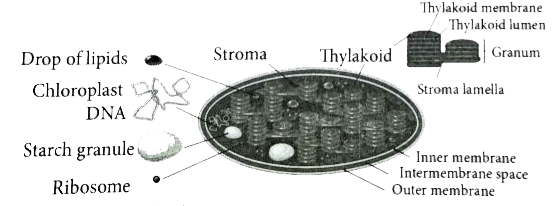 (b) Structure and function of Chloroplast. Chloroplasts are green plastids, containing the green pigment called Chlorophyll. It has the following structures: (i) Envelope: It has outer and inner membranes, which are separated by intermembrane space. (ii) Stroma: Matrix present INSIDE to the membrane is called stroma, which contains DNA, 70 S ribosomes and other molecules needed for protein synthesis. (iii) Thylakoids: It consists of thylakoid membrane that ENCLOSES thylakoid lumen. Thylakoid forms a STACK of disc like structures called granum. (iv) Grana: Some of the thylakoids are arranged in the form of discs, STACKED one above the other called grana. These STACKS are termed as grana, they are interconnected to each other by membranous lamellae called Fret channels. Functions: 1. Photosynthesis 2. Storage of starch 3. Synthesis of fatty acids 4. Storage of lipids 5. Formation of chloroplasts. |
|
| 4834. |
Question : a] Draw a well labelled diagram of human female reproductive system and label the following parts. i] Produces eggs ii] Part where fusion of sperm and egg takes place iii] Part where zygote is implanted iv] Part where sperms enter. b] What happens to human egg when it is not fertilised? |
Answer» Solution :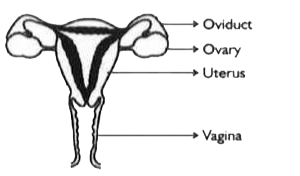 i] Ovary (production of egg) ii] Oviduct (site of fertilization/place where fusion takes place.) iii] Uterus (site of implantation) iv] VAGINA (entry of the sperms) b] Ovulation is when a MATURE egg is released from one of the ovaries. If egg is not fertilised, it will simply move down the FALLOPIAN tube, through the uterus and out through the vagina. The thick uterine walls which were formed for ZYGOTE implantation degenerates and falls resulting in BLEEDING from vagina called menstruation. |
|
| 4835. |
Question : (a) Draw a sectional view of human female reproductive system and label the part where (i) eggs develop. (ii) fertilization take place. (iii) fertilized egg gets implanted. (b) Describe, in brief, the changes the uterus undergoes (i) to receive the zygote. (ii) if zygote is not formed. |
Answer» Solution :(a) The human female reproductive system consists of a pair of ovaries, a pair of OVIDUCTS, the uterus and the vagina. 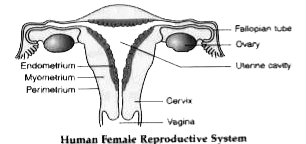 (i) The development of egg occurs in the ovary. (ii) Fertilisation takes place in the fallopian tubes. (iii) The FERTILISED egg gets implanted in the uterus. (b) (i) The uterus prepares itself every month to receive a fertilized egg/zygote. The inner uterus lining (endometrium) becomes thick and is supplied with blood to nourish the EMBRYO. (ii) If the egg is not fertilised, then the uterus lining is not required. Hence, it breaks down and gets released in the form of blood and mucous through the vagina. This process lasts for 2-8 days. This CYCLE occurs every month and is known as menstruation. |
|
| 4836. |
Question : (a) Draw a neatof the stamen of flower. Mark in it filmaent and anther. (b) Draw a neat sketch of the carpel of flower. Mark in it filamnet and anther (c) what is made in (i) anther, and (ii) ovary , of a flower? |
|
Answer» |
|
| 4837. |
Question : (a) Draw a longitudinal section of a flower and label the following parts: (i) Part that produces pollen grain. (ii) Part that transfers male gametes to the female gametes. (iii) Part that is sticky to trap the pollen grain. (iv) Part that develops into a fruit. (b) Differentiate between pollination and fertilisation. |
Answer» SOLUTION :(a) 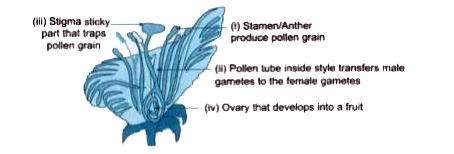
|
|
| 4838. |
Question : a] Draw a diagram of the longitudinal section of a flower and label on it sepal, petal, ovary and stigma. OR Draw the diagram showing the longitudinal section of a flower. Label the following parts : i] Style ii] Anther. b] Write the names of male and female reproductive parts of a flower. |
Answer» SOLUTION :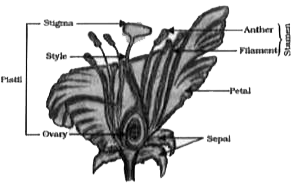 B] Male REPRODUCTIVE part-stamen Female reproductive part- pistil/carpel. |
|
| 4839. |
Question : A distinct thorax does not occur in |
|
Answer» cockroach |
|
| 4840. |
Question : A direct food relation between two species of animals in which one animal kills and feeds on another is referred to as |
|
Answer» PARASITISM |
|
| 4841. |
Question : A digestive enzyme, salivary amylase, in the saliva begin digestion of |
|
Answer» protein |
|
| 4842. |
Question : (a) Differentiate between pollen grains and ovule. (b) State in brief the functions of the following parts of the human female reproductive system: (i) Ovary (ii) Fallopian tube (iii) Uterus. |
Answer» Solution : (b) (i) Ovary - Involved in production of ova and female sex hormone ESTROGEN. (ii) FALLOPIAN tube - Receives ovum after ovulation and is the site of fertilisation (iii) Uterus - Embryo GETS implanted and its DEVELOPMENT TILL child birth takes place here. |
|
| 4843. |
Question :(a) Describe the process of fertilisation in a flower. (b) Why is the number of sperms produced always much more than the number of eggs produced? |
|
Answer» SOLUTION :(a) A pollen grain contains two male gametes. When a pollen grain FALLS on the stigma of the carpel, it grows a pollen tube DOWNWARDS into the style. One of the male gametes Two male reaches the ovary through pollen tube and fuses with egg gametes to form zygote. The other male gamete fuses with two polar nuclei one from each end of EMBRYO sac to form endosperm nucleus. This fusion is called triple fusion. The zygote grows into an embryo and an endosperm nucleus grows into endosperm (the food storage tissue of seed). (b) Sperms are produced much more in number than eggs endosperm cell because: (i) Eggs are non-motile whereas sperms are motile and they may be misdirected while they are travelling towards eggs. (ii) Sperms may not be able to survive under external environmental conditions for long. (iii) To increase the probability of fertilisation of eggs. 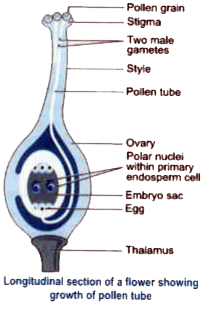
|
|
| 4844. |
Question : (a) Describe the surgical methods of birth control (i) for men, and (ii) for women. (b) Name two devices used in the barrier method of birth control. |
|
Answer» |
|
| 4845. |
Question : (a) Describe asexual reproduction in Amoeba. (b) How does sexual reproduction in plants takes place? |
Answer» Solution : In Amoeba, ASEXUAL reproduction occurs by fission (binary and multiple). In Amoeba, nucleus first divides into two daughter nuclei by mitosis and then body along with the cytoplasm constricts fromthe middle, which gradually deepens and eventually divides into two individual parts, each part has one nucleus. Thus, two daughter Amoebae develop from one. This is called binary fission. In multiple fission, nucleus repeatedly divides to form a large NUMBER of nuclei, which reach at the periphery. Later cytoplasm gathers around each nucleus to form a daughter Amoeba. In this process, several individuals (equal to number of nuclei) develop from a single Amoeba.  (b) Sexual reproduction in plants takes place in the following steps: (i) The male reproductive organ .stamen. MAKES the male GAMETES. (ii) The female reproductive organ .carpel. makes the female gametes. (iii) The male gametes fertilise the female gametes. (iv) The fertilised ovules grow and become seeds. (v) The seeds produce new plants under favourable CONDITIONS like presence of water, warmth, air, light, etc. |
|
| 4847. |
Question : A dental disease characterised by mottling of teeth is due to the presence of an ingredient in drinking water, namely |
|
Answer» fluorine |
|
| 4848. |
Question : (a) Define vegetative propagation. (b) Mention any two methods which use the property of vegetative reproduction to produce new plants. (c) State any one advantage of this method. |
|
Answer» Solution :(a) Vegetative propagation is the process of PRODUCING a new plant USING any vegetative part of the parent plant like root, stem or leaves. (b) Stem cutting and tissue culture are two such METHODS. (c) One ADVANTAGE is plants produced are exactly identical to the parent plant. |
|
| 4849. |
Question :a) Define speciation? b) Mention the sex chromosomes present in human male and human female with the help of a flow chart determine genetically in human beings the sex of the offspring if the sperm carrying x chromosomes fertilizers the egg. |
|
Answer» SOLUTION :a) SPECIATION is arising of a NEW species from a sub-population of a species which is geographically or reproductively isolated over a LONG period of time from the other population of the same species. b) 
|
|
| 4850. |
Question : (a) Define nutrition. Why is nutrition necessary for an organism ? (b) What are the different modes of nutrition? Explain with one example of each mode of nutrition (c) Name the mode of nutrition in (i) roundworm, and (ii) Plasmodium |
| Answer» | |